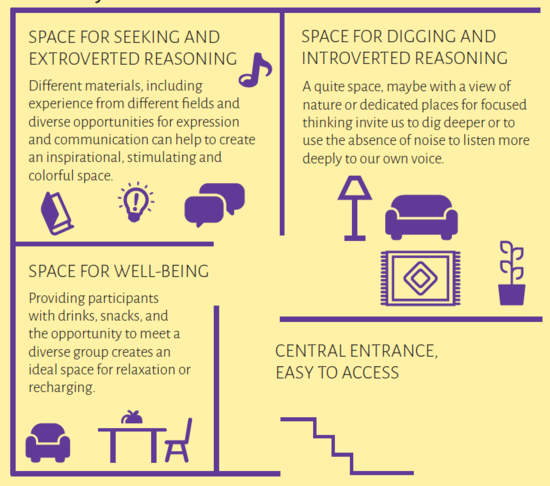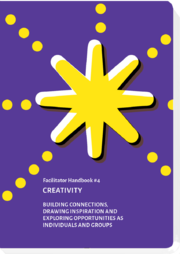Diverse needs
In learning processes learners have different and sometimes opoosing needs. This depends from different parameters. Or the phase of a certain process, or from the personal characteristics or learning preferences of learners. Furthermore, creativity is a process making use of convergent and divergent thinking modes. One might conclude that a creativity enhancing space needs to be open and flexible for serving to the diverse needs.
An inviting facility:
Accessibility
- Are the spaces open and inviting?
- Are they central and easy to reach?
- Are they accessible to all?
- Do they contain the materials needed?
- Do they offer opportunities for different working and thinking styles?
Adapting to existing opportunities
Of course the example in the picture shows the ideal version of creative spaces. However, very often we have to work with what we have.Schools, seminar houses or community buildings already offer a lot of things which are needed for such creative spaces. We have to look at the facilities from a different angle and break the old pattern of their usage:
- What spaces are there? Are they closed? Open areas? With daylight?
- How, when and how often they have been used before?
- With what material should they be completed?
Responding to different needs
- People of different personalities need to feel welcomed
- People with different learning styles need to feel empowered
- People in different steps of a creative process need to feel inspired
Including the spaces in a program
- Include the spaces in your educational work
- Do the participants have enough time to use the spaces?
- Include enough buffer time in your method and learning plan
Take care and maintain
- Make sure that there is enough material
- Take care about cleanness
- Involve the participants to overtake the responsibility for the maintenance of the spaces
Reference
- N. Zimmermann, E. Leondieva (Ed.): Creativity; Facilitator Handbook #4; MitOst Editions 2017
![]() notebook, pens (eventually different colors, tips...
notebook, pens (eventually different colors, tips...
![]() creativity, notes, documentation, journalling
creativity, notes, documentation, journalling
Related:
Also interesting:
Goal
Bullet journalling is a methodology and set of principles aiming to help learners to structure their work, notes, and reflection. In other words: Bullet journalling aims you to make better use of your notebook and to storage your notes easier.
Background
Developed by Ryder Carroll the method became popular due to its adaptability to the different needs of users. The message is: Shape the journal as you like, use the tables, checklists or collections that fit for you. Furthermore, bullet journalling is possible with any kind of notebook, what makes it easy to use in educational context, in example for a learning logbook, or as part of a portfolio. Due to this openness it fits to different kind of learner personalities.
Introduction Into Bullet Journalling
Different Kind of Entries
Basically entries make use of a specific language:
|
· task |
|
○ event |
|
- note |
This makes it possible to change the shape of tasks:
|
· uncompleted task |
|
x completed task |
|
< task to be transferred to the so called future log (a new to do list outside the current month) |
|
> task to be transferred to one of the collections (the monthly plan, or another daily log page) |
These small examples show already, how on the level of the entries some structure helps to structure the mind.
Different Kind of Pages
The System proposes different kind of "logs". A vivid community is continuously coming up with new ideas. In example the jorunal might include
- an agenda,
- opens space for visual notes,
- to-do-lists
- day journals,
- activity or behaviour trackers
- Find here inspiration: Ryder's blog
References
- ↑ Photo: Bich Tran
- ↑ Source of the video: https://bulletjournal.com
Nils-Eyk Zimmermann
Editor of Competendo. He writes and works on the topics: active citizenship, civil society, digital transformation, non-formal and lifelong learning, capacity building. Coordinator of European projects, in example DIGIT-AL Digital Transformation in Adult Learning for Active Citizenship, DARE network.
Blogs here: Blog: Civil Resilience.
Email: nils.zimmermann@dare-network.eu








